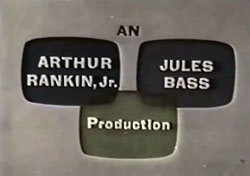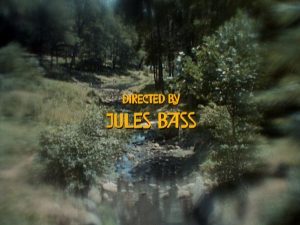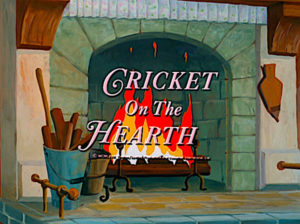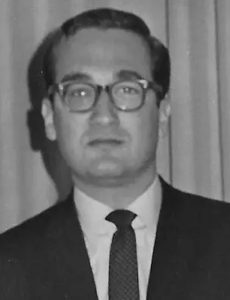A celebration of the talents that Jules Bass brought to the extraordinary partnership that endures through the wondrous works of Rankin/Bass.
A man who’s a dreamer and never takes leave
Who thinks of a world that is just make-believe
Will never know passion, will never know pain,
Who sits by the window will one day see rain.
If I want to change the reflection
I see in the mirror each morn
You mean that it’s just my election
To vote for a chance to be reborn?
If you’re wise, you’re very often acting like a fool to win your game
If you’re daft, just smile and act oblivious, you may even gain some fame!
If I could only get back to yesterday
Oh, the different things I’d do and say.
I’d be a different man if I had a second chance, wouldn’t you, wouldn’t you?
I’d make a special plan if I had a second chance, wouldn’t you, wouldn’t you?
The above lyrics from The Hobbit (1977), Santa Claus is Comin’ to Town (1970), The Daydreamer (1966), and Here Comes Peter Cottontail (1971) are a few of the many ways that Jules Bass has woven his talents into the lives of countless individuals for over half a century and perhaps until the end of time.
 Jules Bass (1935-2022) was one of the two dynamic visionaries behind in Rankin/Bass Productions, the organization TV Guide called the leader in the field of holiday specials. The small yet prolific company was also a contender in Saturday morning programming, theatrical films, TV movies, and recordings.
Jules Bass (1935-2022) was one of the two dynamic visionaries behind in Rankin/Bass Productions, the organization TV Guide called the leader in the field of holiday specials. The small yet prolific company was also a contender in Saturday morning programming, theatrical films, TV movies, and recordings.
Like so many partnerships, the two were very different in personality and general contributions, though their duties overlapped. Arthur Rankin Jr., (1924-2014) had been an art director at ABC before going independent. Rankin was the more outgoing of the two, most often fielding publicity about the projects in addition to supervising animation overseas. Bass was more subdued and intense, a Madison Avenue copywriter imbued with the savvy needed to shape ideas and skills needed to tell stories.
As a copywriter, your author can attest that, on occasion, art directors write and copywriters art direct, depending on the project and work styles involved. Agencies have creative directors who specialize in either words or visuals but, at the director level, preside over both. Rankin and Bass operated similarly, housed in a New York office suite and contracting most of their resources.
 While Rankin was adept at the visuals, he could also take on a feature screenplay, which he did for 1966’s ambitious theatrical feature, The Daydreamer. Bass handled directing duties on The Daydreamer, as well as two other features, The Wacky World of Mother Goose (1967) and the seminal classic Mad Monster Party (1967). They also shared a pseudonym; Julian P. Gardner, often used by Bass and occasionally used by Rankin for various scripting and lyric projects.
While Rankin was adept at the visuals, he could also take on a feature screenplay, which he did for 1966’s ambitious theatrical feature, The Daydreamer. Bass handled directing duties on The Daydreamer, as well as two other features, The Wacky World of Mother Goose (1967) and the seminal classic Mad Monster Party (1967). They also shared a pseudonym; Julian P. Gardner, often used by Bass and occasionally used by Rankin for various scripting and lyric projects.
Writer/producer Peter Bakalian worked at Rankin/Bass starting in the eighties with the hit 1985 ThunderCats series all the way to the final special in 2006, Santa Baby! (which he co-produced and co-wrote). He got to know key people who had been part of the legacy over the years. “They each had tremendous reputations for integrity. They were two of the most respected people in the business.
“Arthur and Jules worked incredibly well together as long as Rankin/Bass existed,” writer/producer Peter Bakalian told me. “They were like brothers. Both were directly involved with various aspects of the projects throughout the process.”
 One of Jules Bass’ outstanding contributions to popular culture is his talent for songwriting. Like many advertising copywriters, Bass surely dabbled in writing songs and jingles. He was able to compose (the ThunderCats theme was among his compositions) but his most prolific and enduring holiday contributions are the lyrics he wrote to the music of Maury Laws (1923-2019).
One of Jules Bass’ outstanding contributions to popular culture is his talent for songwriting. Like many advertising copywriters, Bass surely dabbled in writing songs and jingles. He was able to compose (the ThunderCats theme was among his compositions) but his most prolific and enduring holiday contributions are the lyrics he wrote to the music of Maury Laws (1923-2019).
Laws, who did very few interviews, told me that it was Bass who brought him into the fold. “I first met Jules Bass in 1962 when I was writing for TV commercials. He was a writer for a New York advertising agency and I was doing a lot of things for companies like General Electric.”
They became a songwriting team beginning with the 1966 live-action/animated feature The Daydreamer, they wrote individual songs and/or complete scores for Cricket on the Hearth; The Little Drummer Boy; The Little Drummer Boy Book II; Santa Claus is Comin’ to Town; The Year Without a Santa Claus; Here Comes Peter Cottontail; The Easter Bunny is Comin’ to Town; The First Easter Rabbit; Nestor, the Long-Eared Christmas Donkey; The First Christmas: The Story of the First Christmas Snow, The Wind in the Willows, ‘Twas the Night Before Christmas, Pinocchio’s Christmas; and many other specials, series, and features. In 1977 Rankin/Bass won the Peabody Award for The Hobbit, for which Bass adapted the Tolkien verse to Laws’ music.
 Those of us who love these films have our own favorites, but the most celebrated songs are: “The Heat Miser/Snow Miser Song,” and “Put One Foot in Front of the Other.” I might add “My World is Beginning Today,” “Daydreamer,” “One Star in the Night,” “I Believe in Santa Claus,” “Elbow Room,” “Even a Miracle Needs a Hand,” and three whose lyrics are listed at the start of this article: “The Greatest Adventure,” “Who Can Tell,” and “If I Could Only Get Back to Yesterday.”
Those of us who love these films have our own favorites, but the most celebrated songs are: “The Heat Miser/Snow Miser Song,” and “Put One Foot in Front of the Other.” I might add “My World is Beginning Today,” “Daydreamer,” “One Star in the Night,” “I Believe in Santa Claus,” “Elbow Room,” “Even a Miracle Needs a Hand,” and three whose lyrics are listed at the start of this article: “The Greatest Adventure,” “Who Can Tell,” and “If I Could Only Get Back to Yesterday.”
Almost every Rankin/Bass special is a marvel of tight storytelling with minimal padding, allowing even the songs to suit the situation rather than seem superfluous. “Jules always worked very hard to achieve a rhythmic pace in the shows,” Laws recalled. “He would work out exposure sheets for every section that I would later fill in. We created virtually the entire soundtrack before the animation was done.”
Word of mouth among the show business heavyweights was also good for Rankin/Bass; that was how they managed to cast some stars who never worked in animation before (including Vincent Price, Fred Astaire, James Cagney, José Ferrer, Danny Kaye, and Danny Thomas. Some of these performers could be quite challenging in the wrong hands, but Laws said, “One of the things Jules and I always did was to make the celebrities comfortable with the material. We wrote the songs just for them… I think, for that reason, the stars always liked what we created for them. We never had anyone come back to us later and tell us they didn’t like a song.”
 Bass and Rankin even made visits to Washington to testify about television violence when various groups were attacking the medium. The Rankin/Bass specials were careful to avoid excessive violence and usually ended with a villain’s redemption. Laws recalled veteran screenwriter Romeo Muller referring to all of them as “the Dickens of our time.”
Bass and Rankin even made visits to Washington to testify about television violence when various groups were attacking the medium. The Rankin/Bass specials were careful to avoid excessive violence and usually ended with a villain’s redemption. Laws recalled veteran screenwriter Romeo Muller referring to all of them as “the Dickens of our time.”
This kind of care and remarkable foresight made the work of Rankin/Bass some of the most perennially popular material still in circulation. There is an annual tug-of-war between media distributors about which platforms will be able to run the most popular shows during holiday time.
Our own Jerry Beck reports that the major studios who control the copyrights find that many of the Rankin/Bass properties continue to increase in appeal and are surefire winners – so much so that two entertainment titans, Universal and Warner, have joined forces to create the first-ever DVD set to combine eighteen pre-1970 and post-1970 specials into one deluxe set: The Complete Rankin/Bass Christmas Collection.* Though this set went into production before the world lost Jules Bass, it is surely a de facto tribute to his legacy.
The greatest adventure is what lies ahead
Today and tomorrow are yet to be said
The chances, the changes are all yours to make
The mold of your life is in your hands to break.
“The Daydreamer” Overture
For historical reasons, here is the first score that Bass and Laws ever wrote together. This spectacular overture was created by Laws, especially for the soundtrack album, which is now available in crystalline quality from Sony on most streaming services.
*NOTE: Neither Warner nor Universal control the rights to the Rankin/Bass 2001 hour-long animated special, Santa Baby! (which includes the voices of Eartha Kitt and Gregory Hines), making the new DVD set technically incomplete. The DVD is out of print as of this writing, but it is available on several streaming services.



 GREG EHRBAR is a freelance writer/producer for television, advertising, books, theme parks and stage. Greg has worked on content for such studios as Disney, Warner and Universal, with some of Hollywood’s biggest stars. His numerous books include Mouse Tracks: The Story of Walt Disney Records (with Tim Hollis). Visit
GREG EHRBAR is a freelance writer/producer for television, advertising, books, theme parks and stage. Greg has worked on content for such studios as Disney, Warner and Universal, with some of Hollywood’s biggest stars. His numerous books include Mouse Tracks: The Story of Walt Disney Records (with Tim Hollis). Visit 





















































I will never forget the night when the Rankin/Bass Rudolph the Red-Nosed Reindeer was first broadcast. Our family consisted of four at the time–my parents, my baby brother, and myself, watching on a big black-and-white set. We were captivated and enthralled by the special. Even the commercials were noteworthy, as the elves in the special were promoting various products that were advertised–in those days, commercials were incorporated into the overall viewing experience. If memory serves, General Electric was the big sponsor. I remember this because at the very end I expected the close-up of the moon to transform into a big GE logo–which never happened. (A good thing now, I observe–but at the time the commercial saturation was so complete that it seemed fitting to my young mind.)
We loved the characters. We loved the songs. From that time forward, “A Holly Jolly Christmas” became a family favorite for the holidays. The working out of the plot was nothing less than magical. We didn’t see how Rudolph could overcome his troubles in time to light the way for Santa’s sleigh–but of course it all happened as planned and on schedule.
There is no doubt something special and magical happened that night. We looked forward to the annual re-showings of Rudolph for years to come. And as the R/B catalog expanded to include more specials, we followed them quite enthusiastically. One year when I was in my teens my mother requested me to keep an eye out for a Rudolph sound track record album. That very year there was one available in stores, and so I bought it and brought it home in time for us to enjoy it along with our other Christmas LPs of that season.
If R/B worked so much magic for our small family, there must have been a huge impact collectively for their nation-wide audience. Today it’s hard to imagine a Christmas without an annual visit from the R/B characters. Thanks for this great tribute! (The quotes at the beginning are priceless.)
One of the many strengths of the best Rankin/Bass productions is that their stories are marked by emotional turning points, from which the songs seem to emerge organically. It is the lyrics, above all else, that determine a song’s success in this context. A song with good lyrics can still be effective even if the melody is hackneyed or jejune, but not even a Gershwin or a Tchaikovsky can possibly redeem bad lyrics.
In musical theatre the lyricist has to make his or her point as directly and concisely as possible in order to carry the story forward. Thus every word carries the maximum impact. Maybe his background in advertising had something to do with it, but Jules Bass had this ability in spades. Romeo Muller did not, at least not to the same extent, as his talents lay mainly in storytelling. But Howard Ashman also did. So did Lorenzo da Ponte. And if I’m the first to compare Jules Bass with the librettist of Mozart’s greatest operas, then it’s about time someone did!
They were the First Toymakers to the King!
It’s nice–and only right–that later generations appreciate Rankin Bass, but you really had to be there. If you were lucky enough to be a kid at the time, you understand only too well what the fuss was about. Even if the “Animagic” seems primitive by CGI standards (although smooth animation is not necessarily good animation), the design and personalities of the characters more than compensated. Come to think of it, that’s why so many kids today are either mean or depressed: nobody’s making holiday specials for them.
Jules Bass’ work has been a big part of my childhood. He and Maury Laws made a great songwriting team just like the Sherman Brothers.
They put out a lot of good movies. I particularly liked their trilogy of fantasy movies – the Hobbit, Last Unicorn, and Flight of Dragons. I remember as a kid, their version of the Hobbit was the first thing that gave me an idea of how to draw a pine tree.
I like many of you here grew up with many of these specials as a kid in the 80’s myself. These days the nets, especially CBS play Rudolph at such a fast speed, it’s time compressed for loads of commercials to air. Glad to have it on DVD. Back in the day, CBS played RTRNR at a normal speed, but it was edited for time as such. TV tech was way different back then.
And I am glad Twas the Night Before Christmas is on this massive set, which I have purchased thanks to that link. Haven’t seen it in years. Actually, AMC aired it among many XMAS specials.
Of all the songs from these specials, “Silver and Gold” and “Holly Jolly Christmas” are my favorites, both by Burl Ives.